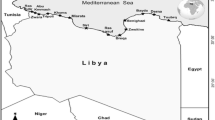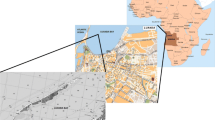Abstract
Total concentration of lead and its individual partitioning, i.e. exchangeable, adsorbed, organically bound, carbonate, sulfide and residual have been assayed in the bottom sediment of Rybnik reservoir applying AAS. The contribution of particular fractions to the total lead concentration was as follows: carbonates (37%) > sulfides (28%) > residual (14%) > adsorbed (10%) > exchangeable (8%) > organic bonds (3%). The multiple regression analysis applied led to the conclusion that the increase in lead content in the bottom sediment resulted from an increase in poorly mobile forms, notably carbonates.
Similar content being viewed by others
References
Atmospheric Pollution: 2000, WSSE, Katowice (in Polish).
Chakrapani, G. J. and Subramanian, V.: 1993, ‘Heavy metals distribution and fractionation in sediments of the Mahanadi River basin, India’, Environ. Geol. 3, 80–87.
Del Castilho, P.: 1983, ‘Ammonium acetate extraction for soil heavy metals speciation; model aided soil test interpretation’, Intern. J. Environ. Anal. Chem. 51, 59–65.
Dojlido, J. R.: 1995, ‘Chemistry of surface waters’, Wydawnictwo Ekonomia i Środowisko, Białystok (in Polish).
Fytianos, K. and Lourantou, A.: 2004, ‘Speciation of elements in sediment samples collected at lakes Volvi and Koronia, N. Greece’, Environ. Int. 30, 11–17.
Galán, E., Gómez-Ariza, J. L., González, I., Fernández-Caliani, J. C., Morales, E. and Giráldez, I.: 2003, ‘Heavy metal partitioning in river sediments severely polluted by acid mine drainage in the Iberian Pyrite Belt’, Appl. Geochem. 18, 409–421.
Gismera, J. M., Lacal, J., da Silva, P., García, R., Sevilla, M. T. and Procopio, J. R.: 2004, ‘Study of metal fractionation in river sediments. A comparison between kinetic and sequential extraction procedures’, Environ. Pollut. 127, 175–182.
Jain, C. K.: 2004, ‘Metal fractionation study on bed sediments of River Yamuna, India’, Wat. Res. 38, 569–578.
Kozłowski, W., Karaś, M. and Fiedler, K.: 1981, ‘Monograph of Rybnik Reservoir’, Wydawnictwo Komunikacji i Łączności, Warszawa (in Polish).
Lis, J. and Pasieczna, A.: 1995, ‘Geochemical atlas of Poland 1:2500000’, PIG, Warszawa (in Polish).
Loska, K., Pelczar, J., Wiechuła, D. and Kwapuliński, J.: 1994, ‘The contamination of lead and chromium in the Rybnik Water Reservoir’, Pollutants in Environment 4/5, 5–11 (in Polish).
Loska, K., Wiechuła, D. and Cebula, J.: 2000, ‘Changes in the forms of metals occurrence in bottom sediment under conditions of artificial hypolimnetic aeration of Rybnik reservoir, Southern Poland’, Pol. J. Environ. Stud. 9, 523–530.
Morillo, J., Usero, J. and Gracia, I.: 2002, ‘Partitioning of metals in sediments from the Odiel River (Spain)’, Environ. Int. 28, 263–271.
Pardo, R., Barrado, E., Perez, L. and Vega, M.: 1990, ‘Determination and speciation of heavy metals in sediments of the Pisuerga River’, Wat. Res. 24, 373–379.
Presley, B. J., Kolodny, Y., Nissenbaum, A. and Kaplan, I. R.: 1972, ‘Early diagenesis in a reducing fjord, Saanich Inlet, British Columbia – II. Trace element distribution in interstitial water and sediment’, Geochim. Cosmochim. Acta 36, 1073–1090.
Prosi, F.: 1989, ‘Factors controlling biological availability and toxic effects of lead in aquatic organisms’, Sci Total Environ. 79, 157–169.
Rudd, T., Lake, D. L., Mehrotra, J., Sterritt, R. M., Kirk, P. W. W., Campbell, J. A. and Lester, J. N.: 1988, ‘Characterisation of metal forms in sewage sludge by chemical extraction and progressive acidification’, Sci. Total Environ. 74, 149–175.
Salomons, W.: 1995, ‘Environmental impact of metal derived from mining activities: Processes, predictions, prevention’, J. Geochem. Explor. 52, 5–23.
Sillen, L. G.: 1961, ‘The physical chemistry of seawater’, in: M. Sears (Ed), Oceanography. Am. Assoc. Adv. Sci., Washington, D.C., 549–581.
Stephens, S. R., Alloway, B. J., Parker, A., Carter, J. E. and Hodson, M. E.: 2001, ‘Changes in the leachability of metals from dredged canal sediments during drying and oxidation’, Environ. Pollut. 114, 407–413.
Tessier, A., Campbell, P. G. C. and Bisson, M.: 1979, ‘Sequential extraction procedure for the separation of particulate trace metals’, Anal. Chem. 51, 844–851.
Tokalioğlu, S., Kartal, Ş. and Elçi, L.: 2000, ‘Determination of heavy metals and their speciation in lake sediments by flame atomic absorption spectrometry after a four-stage sequential extraction procedure’, Anal. Chim. Acta 413, 33–40.
Turekian, K. K. and Wedepohl, K. H.: 1961, ‘Distribution of the elements in some major units of the earth’s crust’, Bull. Geol. Soc. Am. 72, 175–192.
Ure, A. M., Davidson, C. M. and Thomas, R. P.: 1995, ‘Single and sequential extraction schemes for trace metal speciation in soil and sediment’, Techniques and Instrumentation in Analytical Chemistry 17, 505–523.
Weisz, M., Polyak, K. and Hlavay, J.: 2000, ‘Fractionation of elements in sediment samples collected in rivers and harbors at Lake Balaton and its catchment area’, Microch. J. 67, 207–217.
Author information
Authors and Affiliations
Corresponding author
Rights and permissions
About this article
Cite this article
Wiechuła, D., Loska, K. & Korus, I. Lead Partitioning in the Bottom Sediment of Rybnik Reservoir (Southern Poland). Water Air Soil Pollut 164, 315–327 (2005). https://doi.org/10.1007/s11270-005-4771-z
Received:
Accepted:
Issue Date:
DOI: https://doi.org/10.1007/s11270-005-4771-z




